Nutriment Dec, 2017
Introduction
Nutriment is a project that I developed with Ibtasam and Jay for MSTI Design Thinking Studio. We started from idea brainstorming and secondary research, we did primary research to refine our design question and to come up with design requirements, then user scenarios and core tasks were generated, finally we made a low fidelity prototype and conducted some tests to get user feedback.
Through this process, not only did I learned the toolset and methodology of design thinking, but also a mindset and a way of thinking a question. In the remain sections, I will go through the process we did and reflect my thoughts about it.
Idea Brainstorming and Secondary Research
Description
In this phase, we started by introducing ourselves, because knowing and trusting each other is the key to build an effective team, and a good team is the key to a successful project. Then we brainstormed in the three domains we were given, transportation/ commuting, disaster preparedness and resilience and nutritional health. After first round of brainstorming, every one did some secondary research about the topics they brought up and conducted a second round brainstorming.
 Figure 1: Some Sketches to show my ideas
Figure 1: Some Sketches to show my ideas
Secondary research
For the secondary research, I did the popular media research and publications research for the idea I brought up. My idea is a food delivery robot that can collaborate with delivery staff to increase the food deliver power at a low cost. It originated from the Chinese market and after the secondary research, I found that in America food delivery is not that popular and delivery staff usually use vehicles instead of special motor in China. So we decided not to pursue my idea.
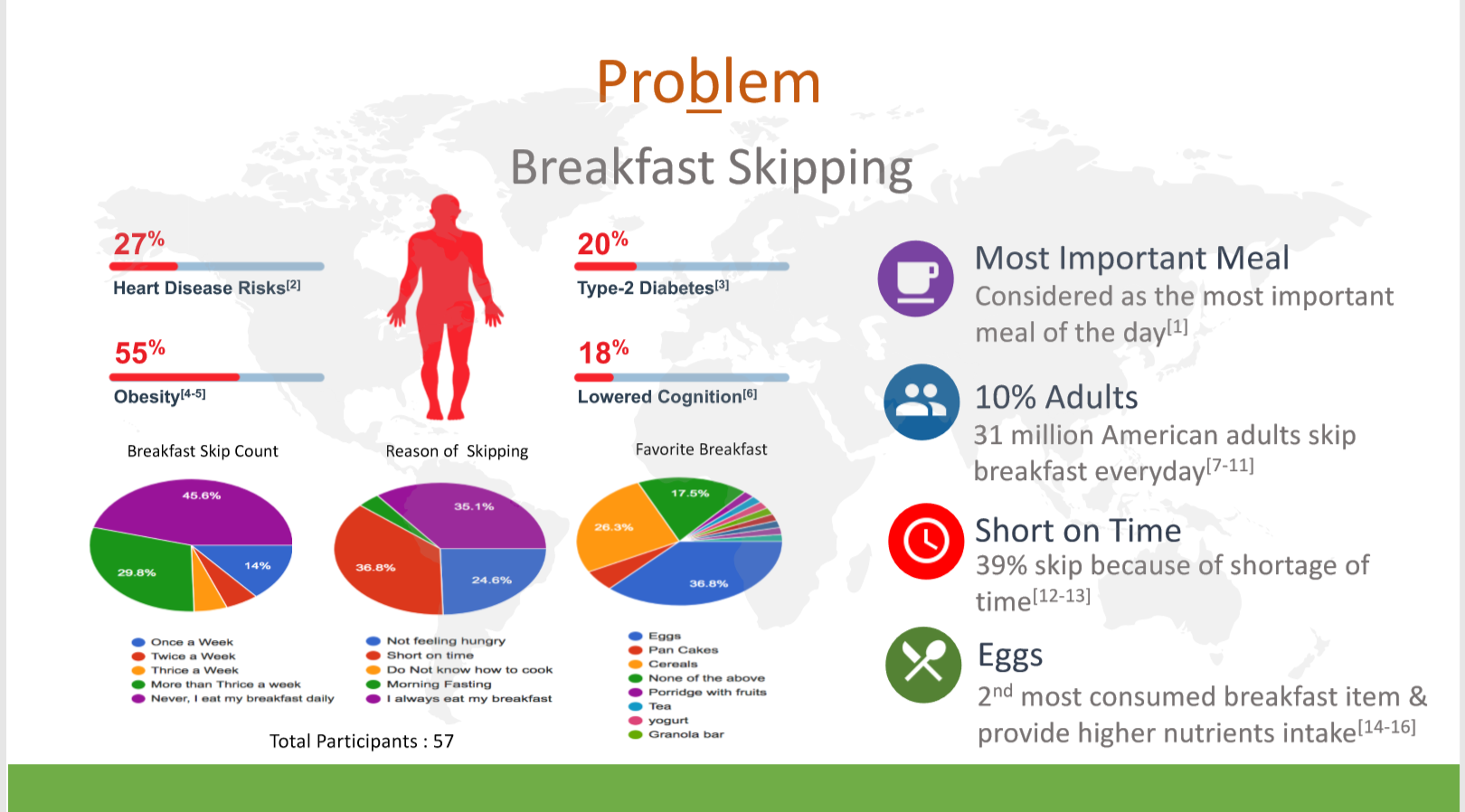 Figure 2: Secondary research result
Figure 2: Secondary research result
Design question
Finally, we settled down to the problem of breakfast skipping. How can we decrease breakfast skipping among young adults and working professionals who are short on time in the US.
Reason for focusing on that space
Other ideas are either hard to do primary research, or too technology-centric that is not suitable for this class, and we are all passionate about breakfast skipping problem because lots of our friends have this problem.
Role
Everyone in this phase contributed their ideas and did the secondary research.
Reflection
Find a right direction to work on is important to future project success. And come up with an idea that has huge value, hasn’t done by others and can be done by us is really hard, especially for us students with limited experience. I think it is a good practice to write it down when you have thoughts about something and finally they will accumulate to a problem that is worth to solve.
Three of us are all from technical background. So it is easy for us to dive into the technical details too early. At that stage we already have an image of breakfast machine we want to make. Now I can see that it’s important to not start from a technology solution.
Primary Research and Requirements
Description
In this phase, we conducted observations, some interviews and survey, then we generated our design requirements from the insights.
We observed our roommates or families living with us, combing with the interviews afterward, one of the important observation is that when the time is limited, women tend to make up rather than have a rich breakfast. This reveals that people have a priority in their mind in the morning. Our assumption is for those skipping breakfast, time is just an excuse and the real reason is the low priority of breakfast.
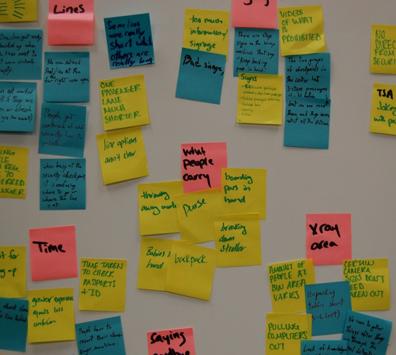 Figure 3: Affinity analysis
Figure 3: Affinity analysis
Then we conducted the survey contains some demographic questions and questions about reasons for breakfast skipping. We found out that people said the most common reasons for breakfast skipping are shortage in time, access to breakfast material and not in mood of cooking.
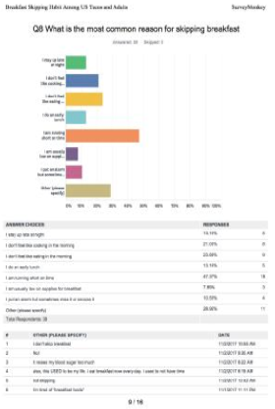 Figure 4: Some of the survey result
Figure 4: Some of the survey result
Refined design questions and design requirements
After looking into the results from our primary research, we refined our design questions to “How can we decrease breakfast skipping among young adults who age between 18 to 34 years”. The change is that we refined our target user to ages 18 to 34 based on our survey.
About design requirements, we summarized the insights from each research phase and did the affinity analysis to organize them into three categories, business, technology and user experience. We also combined some similar ones and brought up some new requirements to complement the whole process.
Role
I contributed lots of insights because my roommates are our typical target users and I learned a lot from the observations and interviews. I also make the team excited about the behavior change problem and the gamification idea which I will mention later. I came up with lots of survey questions and design requirements which are put into the final report.
Reflection
Observations are not enough for our problems because usually morning activities are very private. Even it is my roommates I observed, I still cannot know what they did in their bedroom and restroom. So some interviews are conducted after the observation to get a whole picture of their morning activities. These methods are not universal, we need to adjust them according to our problems.
When I finished the observations and survey, I assumed that for those skipping breakfast, time is just an excuse and the real reason is the low priority of breakfast. So in my mind, this is the pattern of behavior change problem: something is good for long-term but people do not have enough incentives at short-term to do so. I happen to have some knowledge about gamification, which is a theory that can shape people’s behavior. Give them emotional incentives, instant feedback and make minor changes to their daily behavior may help them form a good habit.
Meanwhile, I thought about some interesting ideas. One idea is that we can provide them the nearest Starbucks on their way to work. When they have breakfast there for several days, they will get more Starbucks credits. Another is that they can pay us some money for a breakfast weekly subscription. If they cannot have breakfast for the whole week, their money will be rewarded to those who have finished breakfast. They are also encouraged to share with their friends to engage in this challenge so that they may get money and show off to their friends.
But after finishing the survey, the results could not support my assumption. What participants talked about are all objective reasons such as shortage in time, access to breakfast material, rather than the more important emotional needs that gamification want to address. I think it is because survey is not suitable for validating this kind of assumption. If I have more time next time, I will do more deeply interview to validate some emotional assumptions.
Ideation
Description
With all the user requirements, we started to think about a solution. We thought about some solutions like the breakfast machine, the takeaway breakfast finding platform, the breakfast delivery platform and so on. None of them could meet all the user requirements. But some of the important requirements like the variety of breakfast choices and ready make food could only be met with breakfast delivery solution. So we decided to go to that direction.
 Figure 5: Some sketches to show ideas
Figure 5: Some sketches to show ideas
Then we divided the information from our previous core users and user requirements into three user scenarios and related some core tasks to them. We draw the storyboard to illustrate how our product can make users' life better.
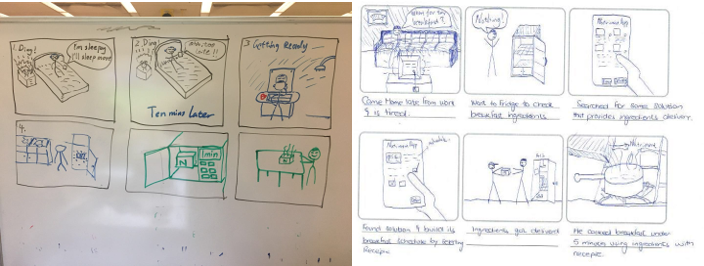 Figure 6: Story board
Figure 6: Story board
Role
I did some sketches, wrote one scenario. I also generated core tasks and technology components with others.
Reflection
As we correctly identified the user requirements, this phase actually went very well and smoothly. This may due to our team’s engineer background, which make us very good at solving problems.
Prototype and Evaluation
Description
In this phase when we have our solution, we need to build a prototype and test it. Here is a link to our Balsamiq prototype https://balsamiq.cloud/sz5j2/pttb8/r2278.
Since our core experience includes two stages, ordering with the app and get the package then cook it, we built a software interactive prototype and a physical prototype. We used Balsamiq to build a low fidelity wireframing prototype for the ordering stage because we want to test the usability of our core workflows. For the cooking stage, I made a physical box prototype and make user think it is the package we will delivery to them, to see the usability of our package design and interaction.
 Figure 7: Prototype
Figure 7: Prototype
Then we conducted the user testing with some of our target users. We gave them instructions and then observed them finished the tasks while thinking aloud. Basically, the result is positive and they can all get the tasks done. A lot of usability problems are also revealed from the evaluation, which may help us build a better product.
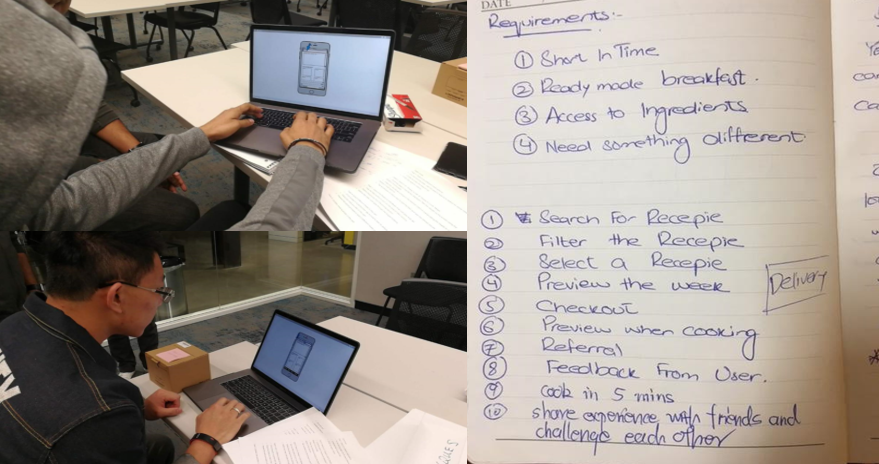 Figure 8: Evalution
Figure 8: Evalution
Role
I collaborated with Ibtasam building the app prototype using Balsamiq, made the box prototype, wrote the instructions and did some usability test.
Reflection
I found out that it is usually better to set a goal for the user and let them think aloud while pursuing this goal, rather than just give them too specific instructions. In this way, we can find out more usability problems of our prototype.
Conclusion
Design thinking actually is a mindset when facing a problem. I used to start thinking technology and solution too early, now I know that we need to kick these off and really think about what user needs. Always ask more whys about user’s behavior, and think deeply about the dynamics of the whole system. Design thinking also gives us a toolset we can use to address these problems. We can select the most suitable ones to our problems. From this course, I get some experiences to use design thinking process in real world problems. It is always a mass in the real world, the process is iterative rather than the liner. All these knowledge and experiences will be super useful for my future projects.